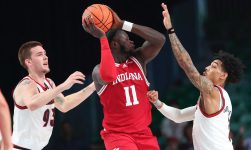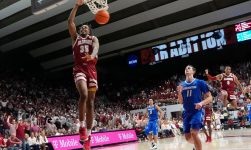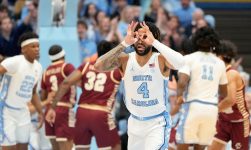CBS Sports college basketball writers Gary Parrish and Matt Norlander surveyed more than 100 coaches for our annual Candid Coaches series. They polled everyone from head coaches at elite programs to assistants at some of the smallest Division I schools. In exchange for complete anonymity, the coaches provided unfiltered honesty about a number of topics. Over the next couple of weeks, we’ll be posting the results on 10 questions asked.
High school basketball prospects have forever had options other than enrolling in college — among them going overseas to play professionally in Europe, Asia or Australia. But there’s no denying there are currently more legitimate stateside opportunities than ever thanks to the existence of the G League Ignite and Overtime Elite.
Both are actively recruiting players.
Both are spending real money.
Class of 2020 five-star prospects Jalen Green, Jonathan Kuminga, Daishen Nix and Isaiah Todd were all successfully lured to the G League Ignite, as were Class of 2021 five-star prospects Jalen Hardy, Scoota Henderson and Michael Foster. Meantime, more than a dozen Class of 2022 and Class of 2023 high-major prospects have signed with Overtime Elite, a new professional league based in Atlanta, most notably Tyler Smith, Jalen Lewis, Matt Bewley, Ryan Bewley, Jean Montero, Jazian Gortman, Amen Thompson and Ausar Thompson. So given that reality — i.e., how these leagues have lured talented players away from college basketball over the past couple of years — Matt Norlander and I decided to ask more than 100 college basketball coaches the following question:
How concerned are you about the G League Ignite and Overtime Elite impacting the future of college basketball?
Not concerned at all43%Mildly concerned34%Moderately concerned13%Very concerned10%
Quotes that stood out
From those who said they’re unconcerned or only mildly concerned”Personally, I’m not that concerned — especially now with the NIL stuff in place. The kids that really don’t have any interest in being on a college campus anyways can go do their thing.”
“Zero concern. College basketball has been around for a century. Nothing will interrupt the role and benefits it has played, and will continue to play, for young kids to achieve their dreams. These pop-up leagues maybe can survive and will always get guys here and there. But the overall stability of college will never falter.””Whoever wants to [bypass college can bypass college] — and we’ll coach the rest of them. I think we forget there’s pride in these institutions. The name on the front means a lot to our fans, and they’ll come out and support whoever puts on the uniforms.” “College basketball is in a great place. We have dealt with change before and continued to find a way to put a great product out there for fans across the country to enjoy. We survived not having LeBron James, Kobe Bryant, Kevin Garnett and on and on. Stars will emerge as upperclassmen — and, frankly, I think that is what the majority of our fans want to see anyway. Players like Drew Timme, Jared Butler, Davion Mitchell and Luka Garza will continue to emerge and keep the future of college basketball bright and exciting.”
From those who said they’re very concerned or at least moderately concerned”I’m not concerned for me personally — but I am worried some kids are getting pulled in a bad direction. A lot of these players Overtime Elite is taking are not NBA players. So what do they do when they leave Overtime Elite? A basketball scholarship is no longer available to them because they’re ineligible. So you’re 19 years old and you’ve blown through whatever money they gave you. Now what? Where do you go?””It is making a significant impact this year. I think the bigger question is: what will the future of these leagues look like — especially Overtime? If it continues to grow and evolve, it will crush the talent pool in college basketball. That’s a fact.”
“At my school, our primary focus is the top 50 to the top 175. That’s where we want to recruit at. But, say, 20 players decide to go to one of those leagues. That shrinks the pool where UConn, Maryland, Louisville, Syracuse and Indiana recruit. Now it’s shrunk and there’s a trickle-down effect. So it will impact a lot of schools like us.”
“Overtime Elite could potentially be very sad. There is no place after OTE for a lot of those kids to go beyond overseas.”
The takeaway
I wasn’t surprised that 77% of the coaches we polled said they were unconcerned, or only moderately concerned, about the G-League and Overtime Elite because, remember, we poll coaches from all levels of Division I — and, to the extent that this is an issue at all, it’s really only an issue at the high-major level. The G-League is largely focused on five-star prospects. And though Overtime Elite is casting a wider net, and pursuing more players in general, they’re not really messing with mid-major and low-major recruits. So mid-major and low-major schools aren’t spending a lot of time pursuing prospects only to have them opt for a professional route.
But that doesn’t mean they can’t be indirectly impacted.
I thought the coaches who referenced how that works made a good point — that for every prospect the G League or Overtime Elite takes from a Duke, Kentucky or similar school, that’s one more scholarship a so-called big boy program will need to fill, often at the expense of a next-tier program. Put another way, the moment John Calipari or Jon Scheyer loses a prospect to a professional league, they’ll just refocus on somebody else, and that somebody else might be a player a next-tier program could’ve gotten if not for Kentucky or Duke deciding to get involved after missing on a superior prospect. And then there’s just a domino effect that slips down through the sport. So that’s worth keeping in mind going forward. But the truth is that, right or wrong, most coaches we communicated with no longer see the G League as a serious threat because whatever amount of money five-star prospects can make in the G League is likely trumped by what they can now legally earn via name, image and likeness rights in college.
Overtime Elite is another deal, though.
The difference between the G League and Overtime Elite is that Overtime Elite isn’t targeting high school graduates for whom college is an option. Overtime Elite is instead targeting prospects who just finished their sophomore or junior years of high school. So those prospects aren’t picking between a paycheck from a professional league and a paycheck via name, image and likeness deals in college as much as they’re picking between a paycheck from a professional league and, you know, just returning to high school.
So it should shock nobody that players are receptive.
The opportunity to make a few hundred thousand dollars before graduating high school is obviously enticing for some — especially for prospects who don’t necessarily project as future NBA players because that really might be the most money they ever make playing basketball. The problem, of course, is something multiple coaches pointed out — that life after Overtime Elite might be limited for a good percentage of those prospects. Understand, anybody Overtime Elite signs is talented enough to be offered a scholarship to play college basketball somewhere. But if college basketball isn’t an option for Overtime Elite alums because they’ve already been labeled professionals and are thus ineligible per current NCAA rules, and if the NBA and G League aren’t realistic options either because they’re not good enough for those leagues, what’s the next move upon graduation? Where do you go? What do you do?
Those are fair questions.
And it should also be noted that Overtime Elite can only be a long-term drain of college basketball talent if it actually exists long term — and several coaches we spoke with are skeptical it’s built to last. For what it’s worth, I’m compelled to point out that Overtime Elite has incredible financial backing and a plan the people behind it believe will work and prove profitable. They acknowledge their skeptics but are not internally skeptical. As always, we’ll see how it goes. But, either way, whether it works long term or not, in the short-term, Overtime Elite is going to take a dozen or two prospects every year who would otherwise eventually play college basketball. There’s no getting around that fact. Regardless, more than three-quarters of the coaches we polled said they’re not really worried about it. They insisted they’ll just keep trying to get the best prospects who choose to remain college-eligible, and they predicted that college basketball in general will suffer very little, if at all. And, at least on that last point, history suggests, they’re likely right. Because if college basketball was totally fine in the absence of LeBron James and Kobe Bryant, the sport probably isn’t going to miss some Bewley brothers and a bunch of other teenagers with zero name-recognition outside of hardcore recruiting circles.
Previously in Candid Coaches:






